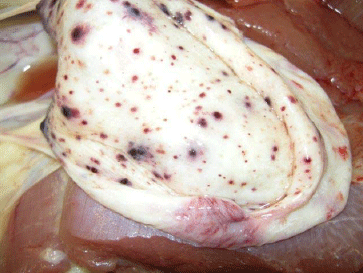



Emerging Threats Quarterly Report – Pig Diseases – April-June 2012
Two outbreaks of conjunctivitis outbreaks and lungworm diagnosed as part of mixed respiratory disease in an outdoor herd are among the conditions reported in the AHVLa report for the second quarter of 2012.Highlights
These reports aim to identify emerging animal disease related threats. Their production is underpinned by a large amount of surveillance data and information compiled as part of the Defra Food and Farming Group animal disease surveillance programme. Some of these data can be viewed on the AHVLA web site.
- Rodenticide exposure in negative notifiable disease investigation
- Coal tar poisoning from roof asphalt
- Respiratory disease diagnoses decline after winter months
Rodenticide Exposure in Negative Notifiable Disease Investigation in Pet Pig
One of two seven-month-old Kune Kune pigs on a smallholding died following clinical signs over the
previous 10 days and was submitted to Bury St Edmunds. Clinical signs began with frank blood in the
faeces and a few days later, blood was noted in the urine. Approximately 10 days later, the pig was
lethargic, anorexic and died. The pig was reported to have been fed kitchen waste and the surviving pig
was reported as pyrexic and dull.
Gross findings were suggestive of a coagulopathy/haemorrhagic
diathesis and included haemorrhages (see Figure 1) into mucosae, skeletal muscle, omentum, intestinal
mucosa and serosa, myocardium, lymph nodes and spleen with blood clots in the renal pelvis and
ecchymotic haemorrhages in the bladder. The farm was using difenacoum and anticoagulant toxicity was
a potential cause of clinical signs. Due to the overall history, the case was reported as suspect swine
fever; however, this was negated following a Veterinary Officer farm visit, which determined that the
surviving pig was clinically normal and there may have been greater access to rodenticide (difenacoum)
than initially reported, in addition to the consumption of poisoned rats.
The case was subsequently
investigated under the Wildlife Incident Investigation Scheme where it was confirmed that three weeks
prior to death, the pig had accessed a bait box containing difenacoum. Advice was given regarding
correct use of rodenticides and prompt disposal of dead rodents. A liver assay indicated the presence of
difenacoum. It is uncertain whether the residue concentration was sufficient to be the sole cause of
death but it is likely to have been a contributory factor.

Due to similarities with this case, a previous case from a different premises in September 2011 was
reviewed. In both incidents, a single seven-month-old Kune Kune pig was affected with a second pig on
site remaining unaffected.
The main findings in the earlier case were severe anaemia and widespread
haemorrhages especially involving the urinary tract, a diagnosis was not established regarding the cause
of death. The affected pig died after several days' lethargy, haematuria and a subnormal temperature.
Although there was no known rodenticide exposure, vitamin K analogue treatment was attempted but the
pig died.
Due to the similarity with the more recent case, the liver was tested for anticoagulant
rodenticide by FERA. Testing confirmed exposure to an anticoagulant rodenticide known as
coumatetralyl; however, the concentration was very low and it may not have been the cause of death in
this pig.
A visit to the premises by a Defra wildlife biologist revealed strong circumstantial evidence that,
although no rodenticide was used by the pig's owners, pigs could have consumed rodents from
neighbouring premises where rodenticide was used.
An alternative diagnosis has not been established
for these Kune Kune pigs, that had similar clinical and pathological presentations at the same age on
separate premises, both with evidence of anticoagulant exposure but with equivocal levels.
Two
possibilities are under consideration; that there is susceptibility to chronic low-grade anticoagulant
toxicity in these pigs or, alternatively, that a similar, as yet undiagnosed disease process occurred in
these two cases.
A publication is planned. The negated notifiable disease case was highlighted in the Veterinary
Record monthly report and AHVLA highlights which go to BPEX and Pig Veterinary Society.
They will also be included in notifiable disease differential diagnoses training presentations.
Ongoing Emerging Disease Investigations
Nothing new to report further to January to March 2012 'Emerging Threats' report.
Unusual Diagnoses or Presentations
There were a number of unusual diagnoses this quarter; details of these have been included in monthly AHVLA reports and AHVLA highlights to BPEX, BPA and Pig Veterinary Society. These will be kept under review to assess whether they justify initiation of emerging disease investigations.
Coal tar poisoning due to ingestion of roof asphalt
All of three pigs recently purchased onto a smallholding died due to coal tar poisoning after gaining
access to roof asphalt that had blown down.
This is another in a series of toxicity incidents involving
coal tar over recent years with other sources including road chippings used to fill pig pen floors, clay
pigeon fragments and tarmac in pen flooring. These incidents are reported as potential food safety
incidents and appropriate steps are taken to protect the food chain. Cases have been presented and
published (Payne and others, 2010; Strugnell and others, 2012) and coal tar toxicity will be
included in a small-holder information leaflet in preparation.
Conjunctivitis outbreaks
Pigs were submitted soon after weaning from two different units with conjunctivitis as an unusual primary
presenting sign together with respiratory disease. On the first, 70 per cent of pigs up to 13 weeks old were
sneezing with nasal discharge and conjunctivitis; no pigs had died or been culled.
Histopathology
revealed a severe subacute to chronic lymphocytic conjunctivitis and mild subacute rhinitis. A
Pseudomonas-like organism was isolated from the conjunctiva in mixed growth with non-haemolytic
staphylococci and extensive testing for other viral and bacterial diseases did not determine the cause of
conjunctivitis, although testing did not include Chlamydia suis, which has been implicated in conjunctivitis
outbreaks in the literature (Schautteet and Vanrompay, 2011).
The pig was negative by both PCR and
serology for swine influenza and PRRSV.
The possibility of exposure to an irritant remains and it was
agreed with the submitting practitioner that if disease occurred again in the next batch of pigs to be
weaned, these would be examined; to date, no further pigs have been affected.
On the second unit,
histopathology revealed a necrotising conjunctivitis, which may have been secondary to PRRS which was
diagnosed. No further action required unless similar cases reported.
Lungworm diagnosed as part of mixed respiratory disease outdoors
Pneumonia due to lungworm (Metastrongylus species) was detected in two submissions from outdoor
units. The intermediate host for this lungworm is the earthworm, to which outdoor pigs have greater
access. Earthworms, and the lungworm larvae within them, can survive for more than five years, making
carry-over of lungworm infection likely on land which is re-used for pigs.
In the first submission,
respiratory disease due to Glässer's and porcine circovirus-2-associated disease (PCVAD) was
diagnosed in 13-week-old pigs submitted from an outdoor rearing site; one of these pigs had
lungworm with numerous worms present in smaller bronchi.
It had been thought that these pigs were
the progeny of sows vaccinated for PCV-2; however, further investigation indicated that this was not the
case and PCV-2 vaccination of weaners was initiated together with anthelmintic treatment for the
lungworm infestation.
On the second unit, respiratory disease and wasting were occurring in successive
batches of outdoor weaners after arrival from outdoor breeding units. In a 13-week-old pig submitted,
many lungworm were visible in smaller airways and histopathology confirmed a severe verminous
pneumonia.
A recent paper linked the occurrence of pneumonia due to Metastrongylus apri with PCV-2
associated disease (PCVAD), suggesting that PCVAD may act as a trigger for more severe disease due
to lungworm, (Marruchella and others, 2012).
Whilst concurrent lungworm and PCVAD causes
severe disease, PCVAD is not a pre-requisite for disease due to lungworm and AHVLA diagnoses
of disease due to Metastrongylus apri in recent years have been both with and without PCV-2
associated disease. Specific interventions to prevent both diseases are appropriate.
Unusual vomiting in gilt litters with rotaviral enteritis
An interesting case of rotaviral enteritis was diagnosed in preweaned pigs. The farmer reported vomiting
as the first clinical sign followed within six to 12 hours by diarrhoea. The problem was mainly seen in
gilt litters and mortality in the farrowing house had crept up from approximately seven per cent to 11 per cent.
Due to the
unusual and predominant sign of vomiting, a farm visit was undertaken and samples collected and tested
for transmissible gastroenteritis and porcine epidemic diarrhoea (TGE and PED); neither was detected.
However, rotavirus was detected in multiple samples. The husbandry was of a very high standard, and
improving on the hygiene measures was considered to be difficult. It was suggested that gilts should be
mixed with younger smaller sows prior to farrowing to try and stimulate immunity to be transferred to
piglets in colostrum. No further action required.
Changes in Disease Patterns and Risk Factors
Respiratory disease diagnoses decline following the winter months
Following the increased diagnoses of both swine influenza and PRRS reported for the first quarter of 2012 associated with the winter months, diagnoses of both declined in this quarter. GB diagnoses of enzootic pneumonia (Mycoplasma hyopneumoniae), and disease due to Haemophilus parasuis and Actinobacillus pleuropneumoniae infections also fell. In England and Wales, GB PRRS diagnoses fell from 11.4 per cent of submissions in January to March 2012 to 5.3 per cent in April to June 2012 while GB swine influenza diagnoses fell from 6.9 per cent of submissions to 2.2 per cent for the same periods, respectively.
Horizon-Scanning
Brucella suis in wild boar in Belgium
Brucella species infection is frequently reported among wild boar populations in Europe. Belgian
researchers have published a survey on Brucella species infection in wild boar populations in Belgium,
concluding that infection is widespread and increasing (Grégoire and others, 2012). Seroprevalences
were reported to have increased over 10 years (35 to 62 per cent depending on the test used), and wild boar
constitute a growing risk of infection to outdoor-farmed pig herds. In addition to wild boars, the European
hare (Lepus capensis) is also considered as a reservoir for B. suis biovar 2 and has been implicated as a
possible source of transmission to domestic livestock in infected countries.
From boars positive in the
indirect ELISA, nine per cent were positive by culture and 24 per cent by PCR when testing spleen and/or
tonsils.
There is ongoing Defra-funded surveillance for Brucella suis in suitable AHVLA diagnostic
submissions from pigs and B. suis has not been detected.
References
Payne, J.H., Murphy, A.M. and Higgins R.J. 2010. Asphalt poisoning in young pigs. Pig Journal, 64:66-68.
Strugnell B., Reichel R., Murray L. Payne J.H. 2012. Coal tar poisoning in grower pigs exposed to road
surfacing used as a straw yard base. Proceedings of the 4th European Symposium on Pig Health and
Management. Bruges, 25-27 April. P057 p.140.
Marruchella G., B. Paoletti, R. Speranza and G. Di Guardo. 2012. Fatal bronchopneumonia in a
Metastrongylus elongatus and Porcine circovirus type 2 co-infected pig. Research in Veterinary Science, 93:310–312.
Grégoire F., B. Mousset, D. Hanrez, C. Michaux, K. Walravens and A. Linden. 2012. A serological and
bacteriological survey of brucellosis in wild boar (Sus scrofa) in Belgium. BMC Veterinary Research 8:80.
Schautteet K. and D. Vanrompay. 2011. Chlamydiaceae infections in pig. Veterinary Research 42:29.
Further ReadingFind out more information on the diseases mentioned in this article by clicking here. |
October 2012








